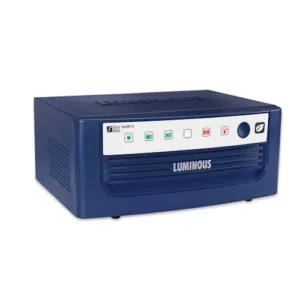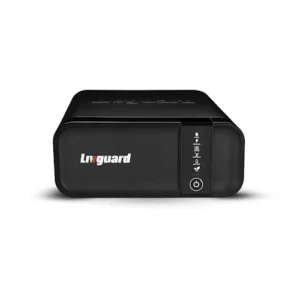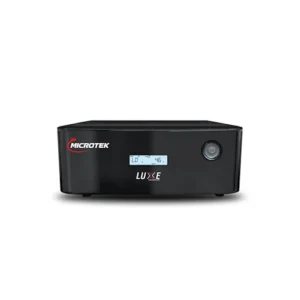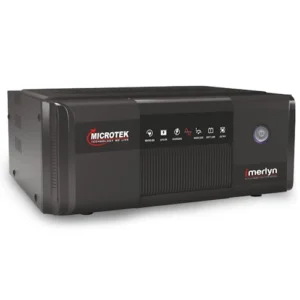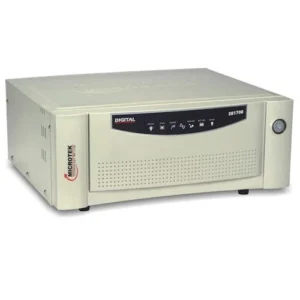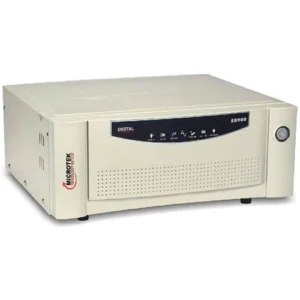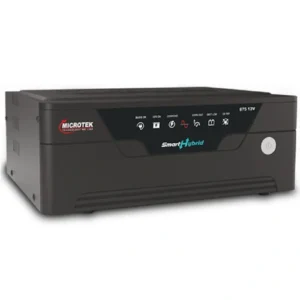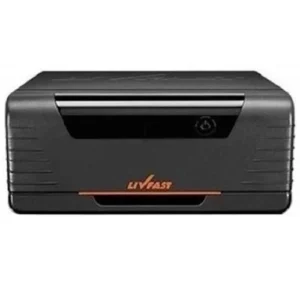Home Inverter
-
Luminous Eco Watt Neo 700 Square Wave 600VA/12V Inverter
Capacity 600 VABrand LuminousWaveform Pure Sine Wave₹4,500.00 -
Livguard LG1100, Square Wave Inverter, 900VA/12V Inverter
- Model Number – i – verter pro
- Warranty – 3 Years
- Rating – 900VA
₹4,400.00 -
Microtek Luxe 1200 Pure Sine Wave 950VA/12V Inverter
Power Source Battery Powered Wattage 760 Watts Model Name Microtek Luxe Series ₹7,200.00 -
Microtek iMERLYN Pure Sinewave UPS Model 1250 12V SW
Recommended Uses For Product Office, Home Power Source Battery Powered Wattage 850 Watts ₹6,400.00 -
Microtek Sine Wave Inverter, for Offices, 1700VA
Capacity 1700VA / 24 VBrand MicrotekPower 1500 W₹8,500.00 -
Microtek 900Va-12V Home UPS Inverter
Capacity 900 VAType UPSFrequency 50-60₹5,200.00Microtek 900Va-12V Home UPS Inverter
₹5,200.00 -
Microtek Smart Hybrid 1875 24V UPS, 1650 VA
Type ModularRated Capacity 1650 VABrand Microtek₹7,700.00 -
Pure Sine Wave Livfast Inverter 1125, FCS1125
Usage for OfficesCapacity 875 VA / 12 VBrand Livfast₹4,999.00
Home Inverter: Your Comprehensive Guide to Reliable Power Backup
Introduction to Home Inverters
In today’s world, a reliable power supply is essential for daily life. Whether it’s for running appliances during power outages, ensuring your home office stays functional, or maintaining the comfort of your home during extreme weather conditions, a home inverter is an invaluable investment. This guide will cover everything you need to know about home inverters, including their features, benefits, types, maintenance, and frequently asked questions (FAQs).
What is a Home Inverter?
A home inverter is an electrical device that converts direct current (DC) from batteries into alternating current (AC) used by household appliances. It serves as a backup power source, ensuring that your essential devices continue to function during a power outage. Home inverters are commonly used in conjunction with batteries and can power everything from lights and fans to refrigerators and computers.
Key Features of Home Inverters
- Inverter Type: Home inverters come in various types, including:
- Pure Sine Wave Inverters: Produce a smooth, clean power output suitable for sensitive electronics.
- Modified Sine Wave Inverters: Provide a less clean output, suitable for simple devices but may cause issues with more sensitive appliances.
- Power Rating: Measured in watts (W), this indicates how much load the inverter can handle. It’s crucial to choose an inverter with a power rating that meets your needs.
- Battery Compatibility: Most inverters are designed to work with specific battery types, including lead-acid, lithium-ion, and gel batteries. Ensure compatibility to optimize performance.
- Transfer Switch: A built-in transfer switch allows the inverter to switch between grid power and battery power seamlessly.
- User Interface: Many modern inverters come with LCD displays that provide real-time information about battery status, power usage, and system alerts.
- Safety Features: Look for features such as overload protection, short-circuit protection, and thermal shutdown to ensure safe operation.
Benefits of Using a Home Inverter
- Uninterrupted Power Supply: Home inverters provide a reliable backup source during power outages, ensuring that your appliances remain operational.
- Power for Essential Appliances: Inverters can power critical devices such as refrigerators, medical equipment, and home offices, allowing you to maintain your routine during outages.
- Cost-Effective: Investing in a home inverter can save you money in the long run by preventing spoilage of food and reducing downtime for home businesses.
- Environmentally Friendly: Many modern inverters can be paired with solar panels, promoting renewable energy use and reducing your carbon footprint.
- Quiet Operation: Unlike generators, home inverters operate quietly, making them suitable for residential use without disturbing your peace.
Types of Home Inverters
1. Standalone Inverters
Standalone inverters are self-contained units that do not require a connection to the power grid. They are ideal for off-grid applications, providing power to homes in remote areas.
2. Grid-Tie Inverters
These inverters are designed to work with the electrical grid, allowing homeowners to feed excess energy back into the grid when using renewable energy sources like solar panels. This can result in credits on your electricity bill.
3. Off-Grid Inverters
Off-grid inverters are used in situations where there is no connection to the electrical grid. They are often paired with batteries to store energy generated by renewable sources.
4. Hybrid Inverters
Hybrid inverters combine the features of grid-tie and off-grid inverters. They can switch between grid power and battery power, making them a versatile choice for many homeowners.
How to Choose the Right Home Inverter
1. Determine Your Power Needs
Start by calculating your power requirements. List all the appliances you want to run during an outage and their wattage. This will help you determine the power rating you need in an inverter.
2. Consider Battery Compatibility
Ensure that the inverter is compatible with the type of battery you plan to use. Different inverters work best with specific battery types, such as lead-acid or lithium-ion.
3. Look for Sine Wave Output
Choose an inverter with a pure sine wave output if you plan to power sensitive electronics. Modified sine wave inverters may not be suitable for devices with complex circuitry.
4. Evaluate Features
Consider additional features such as a user-friendly interface, built-in safety mechanisms, and monitoring capabilities. Some inverters offer smartphone connectivity for remote monitoring.
5. Check the Warranty
A good warranty is a sign of a quality product. Look for inverters with at least a one-year warranty to protect your investment.
6. Read Reviews
Research customer reviews and ratings to get an idea of the inverter’s performance and reliability. Look for feedback on power efficiency, ease of use, and customer support.
Installation and Maintenance of Home Inverters
Installation
While some homeowners may choose to install a home inverter themselves, it’s often best to hire a professional. Here are some key points to consider during installation:
- Location: Place the inverter in a cool, dry, and well-ventilated area to prevent overheating.
- Wiring: Ensure that all wiring is done according to the manufacturer’s specifications and local electrical codes. Proper wiring is essential for safety and efficiency.
- Battery Placement: If using batteries, keep them close to the inverter to minimize voltage drop. Ensure proper ventilation to avoid gas buildup.
Maintenance
Regular maintenance is essential to keep your home inverter in good working condition. Here are some maintenance tips:
- Check Battery Health: Monitor the health of your batteries regularly. Clean terminals and check for corrosion.
- Inspect Connections: Regularly inspect all connections for signs of wear or damage. Tighten loose connections to ensure proper operation.
- Keep the Inverter Clean: Dust and debris can affect the inverter’s performance. Clean the exterior regularly and ensure ventilation is not obstructed.
- Test the System: Periodically test the inverter to ensure it functions properly during an outage. Simulate a power cut to check the automatic switching process.
- Professional Servicing: Consider scheduling professional servicing annually to ensure that all components are functioning correctly and efficiently.
Frequently Asked Questions (FAQs)
1. What is the difference between a pure sine wave inverter and a modified sine wave inverter?
A pure sine wave inverter produces a clean, smooth output similar to that of the electrical grid, making it suitable for sensitive electronics. In contrast, a modified sine wave inverter has a less refined output, which may not be compatible with some sensitive devices.
2. How long can a home inverter run appliances during a power outage?
The duration a home inverter can run appliances depends on the inverter’s battery capacity and the total wattage of the appliances being used. Calculate the total wattage of your appliances and divide your battery capacity by this number to estimate runtime.
3. Can I use my home inverter for solar energy storage?
Yes, many modern inverters are compatible with solar energy systems. Hybrid inverters, in particular, allow you to store excess solar energy for use during outages.
4. How do I calculate the power requirements for my inverter?
List all appliances you want to power during an outage and their wattage (usually found on the appliance label). Add up the wattage to determine your total power requirement, then choose an inverter with a suitable power rating.
5. Is it safe to install a home inverter myself?
While some homeowners may feel comfortable with DIY installation, it is often safer and more effective to hire a licensed electrician to ensure compliance with electrical codes and proper installation.
6. What maintenance does a home inverter require?
Regular maintenance includes checking battery health, inspecting connections, cleaning the inverter, and periodically testing the system to ensure it operates correctly.
7. How do I know when to replace my inverter?
Signs that your inverter may need replacement include frequent failures to switch on, abnormal noises, or erratic power output. If the inverter is more than 5-10 years old, consider replacing it, even if it appears to be functioning.
8. Can I run my refrigerator on a home inverter?
Yes, a home inverter can power a refrigerator, but ensure that the inverter’s power rating exceeds the refrigerator’s wattage, including the starting surge wattage.
Conclusion
Investing in a home inverter is a proactive step towards ensuring reliable power backup for your household. With various options available, understanding your needs and the features of different inverters will help you make an informed choice. By following proper maintenance practices, you can extend the life of your inverter and enjoy uninterrupted power whenever you need it.

